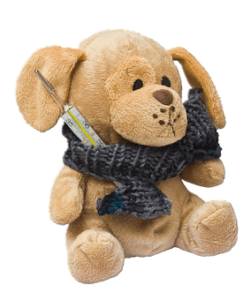Chances are, if you are viewing this article, you may suspect you have a sick dog, or you are researching overall dog care. Either way, good job on being a good dog parent! This article will cover the why, when and how of dog thermometers including reviews of the best thermometers and our recommendations.
First, why do you even need a dog thermometer? Well, the short answer is probably: you have a dog. But most likely you may be trying to weight the pros and cons of the expense of a thermometer. Do dogs even get fevers? Wouldn’t I just take my dog to the vet if they were sick? And these are great questions.

When To Use a Dog Thermometer
It really isn’t all that different than determining when to take your own temperature. When you have a fever you will feel, well, sick. The biggest difference is that your dog won’t tell you they don’t feel well. In fact, animals will almost never “complain” about their illness the way humans do. All this means you will need to be able to read the signs that your dog is feeling under the weather.
Here are some symptoms that will help you determine if your dog is sick:
- Vomiting or diarrhea – seek vet/medical attention immediately if more than once or if can’t/won’t drink water
- Loss of appetite or sudden weight loss/gain
- Excessive sleeping or lethargy; slow or unmotivated more than normal
- Sneezing or coughing <– Just like humans!
- Drinking or urinating
- Physical irritations: red/dry eyes, itchy or flaky skin, dry and warm nose (yes, dogs are suppose to have wet noses!)
- Other behaviors or conditions you believe are abnormal
Like many animals, dogs tend to appreciate routine and with consistent attention, exercise, and diet, their bodies will self-regulate. Therefore, if any behavior changes occur, pay close attention.

On the other hand, you may find that the cold your puppy is facing is a little more serious and has resulted in a fever. A fever, while a natural immune response, can also be life threatening if prolonged. It is important to seek the advice of a veterinary professional any time you are faced with a feverish dog.
How To Take a Dog’s Temperature
A dog’s normal body temperature is between 101 and 102.5ºF (degrees Fahrenheit). A human temperature range, by comparison, is 97.6-99.6ºF. It is important to note this difference when searching for a dog thermometer because some of the more advanced digital thermometers may be pre-programmed to register human ranges.
The process of taking a dog’s temperature varies based on the type of thermometer used. There are two primary ways to take your dog’s temperature: through the ear canal (in-ear) or through the rectum.
A note about calming your dog
Whether inserting a thermometer through the ear canal or rectally, it may still cause some distress to your puppy. This is, after all, an unusual experience. You can make sure you have the best success with taking a temperature by following these steps:
- Stay calm. Dogs, and animals in general, can sense if you are agitated, scared, or upset. If a dog feels their human companion is experiencing distress, this may cause them distress as well. They are pack animals, after all, and their ability to read the feelings of their housemates is important. By staying calm, this will indicate to your dog that they don’t need to worry. If you are established alpha, they will take their cue from you.
- Use a soothing voice. Let your dog know you care and everything will be fine by using a calm and soothing voice. The voice you might use when petting them as they fall asleep.
- Get into a comfortable position. After you retrieve the thermometer from wherever you store it, take a seat in your favorite chair or the floor, where you and your dog typically spend time together. A familiar and comfortable place will be more soothing if your dog. Allow a few minutes to relax with your dog. It is likely that if your dog isn’t feeling well they will appreciate the comfort of this bonding time.
- Have a helper. It can be helpful for you to have another person with you to keep the dog calm while you insert a thermometer, or help hold an ear or leg in place during insertion. While we don’t recommend tightly restraining your dog, as this can cause them to panic, gently hugging them can comforting, depending on the relationship you have with your dog. Make sure this helper is another member of the household they trust. Do not enlist the help of someone your dog doesn’t know or trust unless they are a veterinary.
- Stay aware of your dog’s comfort level. During the process of taking a temperature, remain aware of how your dog is feeling. Are they starting to panic? Do they seem uncomfortable but able to stay calm during the process? It can take some time for a dog thermometer to properly read the temperature; during this time make sure you are still using a calming voice, petting your dog, and keeping them in a comfortable position. If your dog starts to panic or tries to run away, remove the thermometer and try again in a little while.
In-Ear Dog Thermometers
If you are using an in-ear thermometer, the good news is that it is less invasive and may be easier to use because of your dog’s comfort level. However, it isn’t as accurate of a reading as a rectal thermometer, so you will need to follow directions closely.
Typically, an in-ear thermometer is a digital thermometer (vs. mercury). Some digital thermometers need to be “calibrated” first – meaning, they need to be able to read the temperature around them prior to being inserted or used on the dog. Typically these types of thermometers will use a laser or other digital reader to determine the temperature in vicinity or through an opening.
Once a digital thermometer has been calibrated, follow the directions for that thermometer. In most cases, this involves inserting the thermometer into the ear of your dog. Don’t use in-ear thermometers rectally! They are not meant for this purpose and can provide an inaccurate reading, be difficult to clean properly, and cause injury to your dog.
- Calibrate the thermometer prior to insertion.
- Take your dog’s temperature inside, or in a warm space. Avoid taking a temperature outside in cold weather as the dramatic change in temperature may result in an inaccurate reading or the necessity to keep a thermometer in place longer.
- Make sure the thermometer is fully inserted, but not pushed so far that you feel resistance (this could damage your dog’s precious hearing).
- Keep the thermometer in place correctly for the duration of the necessary time to take the reading.
- Take the temperature of your dog regularly, in intervals of 2 hours (especially if a fever is detected) to compare the results and rule out inaccurate results.
Once a temperature has been reached, write the temperature down so you can refer to it during the course of care. If you register a fever (or if your dog is hypothermic, below normal) call your vet. If your dog has a normal temperature but is still showing signs of illness, continue to take their temperature every few hours until they show signs of feeling better.

Pros and Cons of an In-Ear Dog Thermometer
Looking to decide if this thermometer is for you? Here are some pros and cons for a digital in-ear thermometer.
Pros
- They are easy to use
- They feel less invasive for your dog
- Some can store temperatures, making recording an easy process
- They don’t need to be sterilized after use
- Can provide a quicker reading, depending on the device
Cons
- They are larger and therefore take up more storage space
- They may not provide as accurate of a reading
- The beeping my startle your dog
- They are more expensive
Now that we’ve covered the pros and cons, if you are interested in an in-ear thermometer, here are thermometers we recommend.
Pet Clinic iCare Pet Infrared Thermometer
This thermometer is an ear thermometer, but can also be described as a non-contact thermometer because it does not have a protrusion that sticks into your pet’s ear. Instead, this thermometer is held close to the ear canal and an infrared light measures the temperature. It is a truly non-invasive way to take you dog’s temperature, without having to disturb them.
Consider this thermometer:
- (Unlike an Ultrasound scan) It can quickly scan the temperature of your pet’s ear
- Allows storage of 32 previous readings. It helps with recalling temperatures during your dog’s illness
- No need to clean and sanitize after use
- Also takes the temperature of nearby objects and liquids, as well as surrounding air temperature
The drawbacks:
- Sacrifice of accuracy with an accuracy range of +/-0.4°F
- Online reviews vary
Pro Tech Care Digital Thermometer – Ear and Forehead Thermometer
While not listed as a dog-specific thermometer, it will still work for your needs. This thermometer uses an infrared laser to gauge the temperature, both on humans and pets, and can be used in the ear or on the forehead with different attachments. We recommend an in-ear reading for two reasons: 1) in-ear readings provide better accuracy because they are internal and 2) forehead readings are difficult to discern with a pet with fur – the fur will block the skin exposure needed to take an accurate reading unless your dog is very feverish.
Reasons why this thermometer is great:
- It is quick. As in, 1-second quick. This means less time keeping your puppy still.
- It has an easy to read digital display.
- You can mute the sound so it doesn’t beep in your dog’s sensitive ears.
- It comes with batteries and a cloth case
Things to keep in mind:
- There is a green/yellow/red light that indicates if a fever is detected. This is registered for humans and your dog’s temperature, when normal, will still register as a fever on the device.
Vive Precision Tympanic Thermometer – Digital In Ear Thermometer
This is another digital thermometer that doesn’t specify dog use but has all the features you would need to feel comfortable getting a reading from your pet. This thermometer has an easy-to-use, one-button system with a quick read. The digital reading on the front of the product has a blue backlight, which makes it especially easy to read in darker spaces or corners with less light. It also comes with a zippered case for safe storage.
Reasons to consider this thermometer:
- It can be easily operated one-handed because it is small and curves to the shape of your palm. This is helpful if holding a dog or his or her head in your other hand or arm.
- The company boasts a promise for accuracy, which is definitely something you want for your dog’s temperature reading.
Things to keep in mind:
- It takes lithium batteries, which may be less commonly found in households, requiring you to buy separate batteries for this device.
- Reviews for this product vary, but it still comes in at 3.5 stars.
Final note about in ear thermometers
While recommendations for taking the temperature of a human child or baby may lean toward in ear thermometers (especially for babies, as oral thermometers can be dangerous), the common practice for taking the temperature of an animal is still rectally. The reason for this is because the reading is more accurate. Therefore, when looking into digital in ear thermometers, you may be exchanging accuracy for convenience.
Rectal Thermometers
A rectal thermometer is exactly as it sounds: it takes your dog’s temperature by being inserted through the rectum. Rectal thermometers may be digital or non-digital.
Non-Digital / Mercury Thermometers
A mercury thermometer was an old-fashioned type of thermometer where the element mercury resides inside a thin, glass, cylinder, with markings denoting the temperature. When the temperature rises the mercury expands, filling the cylinder to a marked temperature reading. Mercury thermometers were fairly accurate when cared for properly, and used correctly. They don’t require batteries and can be easily sterilized after use.
However, there has been a move away from mercury because if the cylinder were to break, the contents (mercury) is toxic to humans and pets. If you have a mercury thermometer, we recommend researching how to properly dispose of it in your area.
If you prefer using a glass thermometer, there are mercury-free alternatives on the market. Make sure that you find a thermometer that is intended to be used either orally (for humans), or rectally (for pets or babies), instead of for lab work or determining liquid temperatures.
Following the same steps above to calm your dog. Once ready, position yourself at your dog’s hindquarters.
If you are using a non-digital thermometer, shake the cylinder until the liquid is at the bottom of the glass. If using a digital thermometer, turn it on and follow instructions to calibrate it if necessary.
When you are ready, hold your pet’s tail firmly in one hand at the base. Be careful not to squeeze the tail, as this could hurt your dog. Hold the tail out of the way and prevent your animal from sitting down on their butt. It is preferable if they are already sitting on their feet, stomach, or lying on their side.
Insert the tip of the thermometer into your dog’s anus. A slight twisting motion while you do this can help it insert gently. You want to avoid damaging your pet’s rectum, so move slowly. Insert the tip 1 inch for small dogs and up to 3 inches for large dogs.
If you are using a non-digital thermometer, hold in place for roughly 2 minutes. Digital thermometers may get a reading more quickly. This is the part of the process where you will want to keep reassuring your pet, who will likely be very uncomfortable at this point. Say your dog’s name, stroke their ears and head, and try to keep them comfortable. The key here is to keep your pet from moving.
Once the thermometer beeps, or enough time has lapsed, slowly remove the thermometer in the same direction you inserted. Don’t bend as you retract and continue to hold your dog’s tail steady. Remember: you can damage to your dog’s rectum when removing a thermometer if not careful!
After you have removed the thermometer, record the reading. If the digital thermometer has the capacity to store the reading, save it, otherwise, write it down. Writing down the reading is helpful for two reasons: our capacity to remember numbers is not as great as we like to assume; and you will want to take multiple readings and compare them.
Finally, release your dog if they have been hoping to get away and wipe off and clean the thermometer. You know where it has been, after all. Digital thermometers may come with instructions on how to clean, but we recommend wiping down, possibly rinsing, and using rubbing alcohol. Consult instructions for details.
Pros and Cons for Rectal Thermometers
Pros
- Incredibly accurate
- Used by veterinarians and many are made specifically for animals
- Non-digital doesn’t require batteries
- Wide variety of products and easy to find
Cons
- Invasive and require a cooperative dog
- Requires more cleaning
- May inflict damage if not used properly
Looking for rectal thermometers? Here is what we recommend:
Aurynns Pet Thermometer
Listed as a highly recommended pet thermometer, this device is specifically calibrated to meet the range of both pets and livestock, going up to 109° F. While larger than most digital thermometers, this device is ergonomically designed to fit in your hand, giving you the ability to grip firmly and not worry about fumbling or losing position. The bend in the design means you can hold onto the device securely with plenty of room for insertion. Best of all, the reading is quick for a digital thermometer and you can be done in under a minute.
Why we recommend this thermometer:
- Was built from the perspective of veterinarians. Comfortable, easy to use, easy to clean.
- Sensor set to normal animal temperatures. When a fever is detected, the device will beep; but, unlike baby thermometers, the range will be accurate to your dog’s normal temperature.
- Wrist-band. While it isn’t something you might normally think of, the wrist-band is to help you from dropping it. More importantly, if your dog were to get startled and run off, they wouldn’t run away with the thermometer in place!
- Automatic shut-off. This is a helpful feature because after you have finished taking your dog’s temperature, you may be distracted with reassuring them that everything is fine and “it was just as unpleasant for me as it was for you.” If you forget to turn off the thermometer, it will automatically shut off, saving the battery. The last thing you want is to need your thermometer and the battery is dead!
Keep in mind:
- Like in ear thermometers, this is a larger device. You need to have a suitable place to store it.
- The product description says it can read a temperature in 6 seconds, but according to a reviewer on Amazon, the instructions that come in the box recommend 30 seconds.
iProvèn Thermometer (DT-K117A) – Suitable for Pets
Accurate and easy to use, this thermometer meets all the basic requirements you might look for in a pet thermometer. It has a wide range of temperatures, perfect for capturing pet ranges. It has a versatile design that makes following instructions (like ours) easy. And finally, with a high rating, this pet thermometer has proven to be useful for many other pet owners.
Things we love about this pet thermometer:
- It is water-proof for easy cleaning
- A flexible tip makes it safer for pets
- The device is small, making it easy to add to a pet first-aid kit and not take up much space
- Comes in different colors
- Comes with a hard case for extra protection
It doesn’t include:
- Memory function. You will need to write down temperatures in order to refer back to them.
We hope these instructions and recommendations have been helpful for you in identifying how to use a thermometer on a dog, as well as which dog thermometers are the best fit for your household.

![Shih Tzu Poodle mix [Your complete guide to Teddy bear dog | Shih Poo | Shoodle or Pooshi] Shih Tzu Poodle mix [Your complete guide to Teddy bear dog | Shih Poo | Shoodle or Pooshi]](https://shihtzuexpert.com/wp-content/uploads/2020/06/Are-You-a-Good-Match-for-a-Shih-Poo.jpg)
![6 Best Dog Treadmills for 2023 [Buyer’s Guide] 6 Best Dog Treadmills for 2023 [Buyer’s Guide]](https://shihtzuexpert.com/wp-content/uploads/2019/04/Best-Dog-Treadmills-1.png)
![12 Best Dog Foods for Toy Breeds [Buyer's Guide] 12 Best Dog Foods for Toy Breeds [Buyer's Guide]](https://shihtzuexpert.com/wp-content/uploads/2019/05/3-5.jpg)



